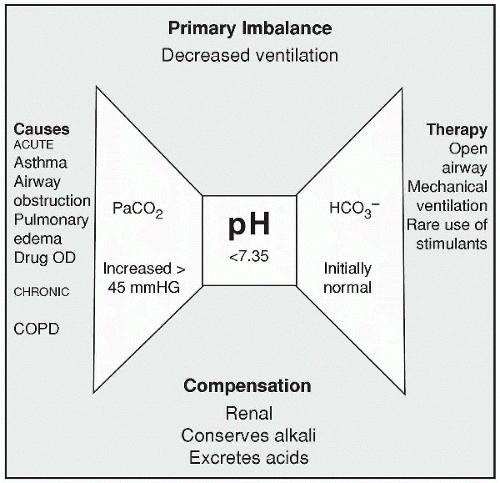Respiratory Acidosis
QUICK LOOK AT THE CHAPTER AHEAD
Respiratory acidosis occurs when the pH value decreases below 7.35 and the PCO2 level rises above 45 mm Hg. Causes may be acute or chronic. In this chapter we describe the conditions that may cause respiratory acidosis, the manifestations, and the treatment, which is aimed at relieving the hypoxia and hypercapnia.
Respiratory acidosis occurs when the pH value decreases below 7.35 and the PCO2 level rises above 45 mm Hg from hypoventilation. Alveolar ventilation becomes impaired, causing an increase in carbon dioxide and carbonic acid. The carbonic acid dissociates, allowing for free H+, which contributes to the drop in pH. Acute and chronic conditions may be responsible.
Acute Respiratory Acidosis
Acute respiratory acidosis may be caused by trauma that causes chest injury and impairs the respiratory system. A bronchial asthma attack, a sudden onset of pulmonary edema, drug overdose, airway obstruction, or head trauma causing a brainstem injury may also lead to difficulty breathing and
the subsequent development of acidosis. The elderly have the potential to succumb to respiratory depression and therefore respiratory acidosis. As one ages the ability to clear drugs efficiently through the renal system is decreased; therefore taking medications, such as barbiturates, can cause a respiratory depression due to the decreased renal clearance.
the subsequent development of acidosis. The elderly have the potential to succumb to respiratory depression and therefore respiratory acidosis. As one ages the ability to clear drugs efficiently through the renal system is decreased; therefore taking medications, such as barbiturates, can cause a respiratory depression due to the decreased renal clearance.
Stay updated, free articles. Join our Telegram channel

Full access? Get Clinical Tree




